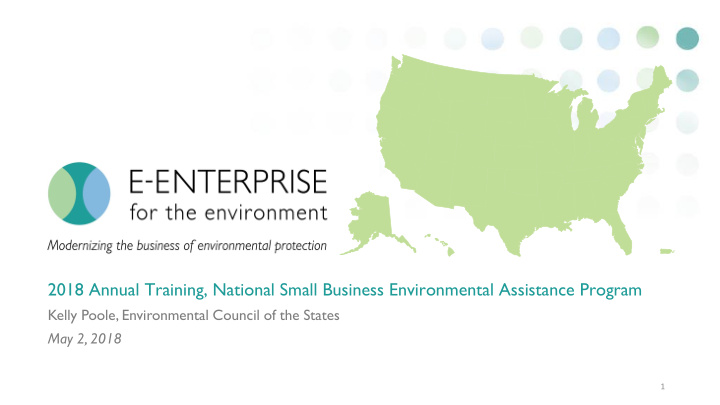



2018 Annual Training, National Small Business Environmental Assistance Program Kelly Poole, Environmental Council of the States May 2, 2018 1
E-Enterprise for the Environment Shared Governance & Cooperative Federalism Optimizing Technology Streamlining Processes • Advanced Monitoring • E-Reporting/E- • Lean Culture Permitting • Business Process Improvement • Portal Development • Burden Reduction • Shared Services 2
Environmental Information Exchange Network • Standardizing Data Exchanges • Collaboration on technological innovations, solutions and services for sharing data. • 2018 E-Enterprise National Meeting 3
E-Enterprise for the Environment Leadership • E-Enterprise Leadership Council • Co-Chairs • Henry Darwin, Chief of Operations, U.S. EPA • Becky Keogh, Arkansas Department of Environmental Quality • Micco Emarthal, Seneca-Cayuga Nation, Tribal Co-Chair, RTOC 6 • E-Enterprise & Exchange Network Management Board • Interoperability and Operations Team 4
Characteristics of an E-Enterprise Project • Streamline and modernize business processes including input from all stakeholders • Introduce technology where appropriate to maximize efficiency • Ensure buy-in and adoption of the streamlined process through joint governance Output Input People Process 5
Combined Air Emissions Reporting T eam (CAER) Team Co-chairs: Marc Houyoux (OAQPS) and Bryan Shaw (TX) • Project Goals: For more information, contact: 1. Reduce industry burden for point source • Julia Gamas at reporting. gamas.julia@epa.gov 2. Improve timeliness and data transparency. Michael Burton at • burton.michael@azdeq.gov 3. Create consistent information across air • Mark Wert at emissions programs. mark.wert@state.ma.us 4. Improve data quality. 5. Improve accessibility and usability of data. 6. Support more timely decision-making 6
E-Enterprise Conceptual Electronic Reporting Workflow (CAER Application) State or EPA Data Systems Pre-populate form with previously summited information AND Receives Information Submitted via Common Emissions Industry Common Emissions E-Enterprise Federal Form User Form Federated Identity Program Emissions (to be developed) Bridge Interface State Data _____________ _____________ (completed proof of concept) Industry _____________ _____________ Systems Services _____________ _____________ _____________ _____________ Reports _____________ _____________ (to be developed) _____________ _____________ _____________ _____________ State/Tribal _____________ _____________ State/Tribal _____________ _____________ State/Tribal EPA _____________ _____________ Program State/Tribal _________ _________ Program Program Systems Interface(s) Program Interface(s) Interface(s) Interface(s) Facility and Sub-facility Data Prepopulated from Facility Systems (services to be developed) E-Enterprise Facility ID Management Services State EPA FRS Facility Orange = E-Enterprise Shared Services System 7
Facility T eam (Phase II) • Team Co-chairs: Susan Joan Smiley (OEI) Ron Evans (OAQPS) and Joshua Kalfas (OK) & Ben Way (WY) Project Goals: 1. Help programs and agencies manage their responsibilities more efficiently. 2. Reduce industry reporting burden of redundant facility information. 3. Assemble more quickly the multi-media environmental data needed for consolidated reports, permits, and inspections. 4. Provide the public a more complete understanding of regulatory obligations and environmental impacts of each facility. 5. Increase facility data accuracy. 8
State Plan Electronic Collection System (SPeCS) Team Co-chairs: Ron Evans (OAQPS) & Robert Bielawa (NY DEP) • An integrated electronic submission, review, and tracking system for State Implementation Plans (SIPs) and other air agency submissions that enables EPA and SLTs to: For more information, contact: Mia South at south.mia@epa.gov • • Manage plan submission and review process more Robert D. Bielawa at • robert.bielawa@dec.ny.gov efficiently and effectively; • Increase transparency through greater “real - time” data availability; and, • Enhance collaboration among different levels of government. 9
Advanced Monitoring Strategy and Implementation (AMSI) • Team Co-chairs: Ben Grumbles (MD) & David Hindin (OECA) • Environmental monitoring technology is rapidly changing - smaller, cheaper, and more portable devices. • Uncertainty about the quality of the technologies and the data produced. • The new technology has the potential to radically improve the effectiveness of environmental protection efforts by government agencies and to greatly enhance community participation. • Advanced Monitoring Technology: Opportunities and Challenges A Path Forward for EPA, States, and Tribes • Preparing for Personal Air Sensors: State and Local Air Quality Agencies on the Frontlines of Citizen Science For more information, contact: • Leslie Cronkhite at cronkhite.leslie@epa.gov • Kelly Poole at kpoole@ecos.org 10
E-Enterprise Portal • Allow the regulated community and the public to more easily access information that is important to them, and provide a more consistent way for environmental agencies to interact with these constituencies. • Reduce the time and effort needed to perform transactions https://youtu.be/iFv0DYnW1-A with U.S. EPA, states, and tribes. For more information, contact: • Shana Harbour at harbor.shana@epa.gov • Laura Letson at letson.laura@epa.gov 11
Contact Information: Kelly Poole, JD Senior Project Manager Environmental Council of the States 202-266-4939 kpoole@ecos.org Thank You 12
Recommend
More recommend